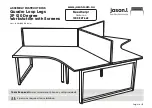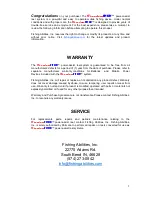
8
OM-BPM-15/30/40G(C,A,C2T™) & BPP-30/40G(C,A,C2T™) Domestic
CLEANING
WARNING: KEEP WATER AND SOLUTIONS OUT OF CONTROLS AND ELECTRICAL
EQUIPMENT. DO NOT USE A HIGH PRESSURE HOSE TO CLEAN THE CONTROL
CONSOLE, ELECTRICAL CONNECTIONS, ETC.
CAUTION: MOST CLEANERS ARE HARMFUL TO THE SKIN, EYES, MUCOUS
MEMBRANES AND CLOTHING. PRECAUTIONS SHOULD BE TAKEN TO WEAR
RUBBER GLOVES, GOGGLES OR FACE SHIELD AND PROTECTIVE CLOTHING.
CAREFULLY READ THE WARNINGS AND FOLLOW THE DIRECTIONS ON THE
LABEL OF THE CLEANER TO BE USED.
WARNING: DO NOT SPRAY WATER DIRECTLY ON BURNERS AND GAS COMBUSTION
CHAMBERS.
NOTICE:
NEVER LEAVE A CHLORINE SANITIZER IN CONTACT WITH STAINLESS STEEL
SURFACES LONGER THAN 30 MINUTES. LONGER CONTACT CAN CAUSE
CORROSION.
Use a brush, sponge, cloth, plastic or
rubber scraper, or plastic wool to clean.
Don’t use metal
implements or steel wool.
1. Before any cleaning operation, shut off the burner by turning the main power
switch to “OFF”. If water or cleaning solution will be sprayed, unplug the unit
from the electric power source, or shut off the power at the circuit breaker or
fuse panel.
2. Clean all food-contact surfaces soon after use, before the pan has cooled
completely. If the unit is in continuous use, thoroughly clean and sanitize both
interior and exterior at least once every 12 hours.
3. Scrape or rinse out large amounts of food residues, then wash the inside
of the pan body with a mixture of hot water and soap or an appropriate
detergent, such as Mikro-Quat from ECOLAB. Follow the detergent supplier’s
recommendations on strength of the solution to use. Rinse the pan thoroughly
with hot water and drain completely.
4. To remove materials stuck to the equipment, use a brush, sponge, cloth, plastic
or rubber scraper, or plastic wool along with the detergent or soap solution.
To minimize the effort required in washing, let the detergent solution sit in the
pan and soak into the residue, or heat the detergent solution briefly in the pan.
Do NOT use any abrasive materials or metal implement that might scratch the
surface, because scratches make the pan hard to clean and provide places for
bacteria to grow. Do NOT use steel wool, which may leave particles imbedded
in the pan surface and cause eventual corrosion and pitting.
5. As part of the daily cleaning program, clean all external and internal surfaces
that may have been soiled. Remember to check such parts as the underside
of the cover, control console, etc.
6. Controls and the control console may be cleaned with a damp cloth or sprayed
with a garden hose spray connected to city water supply. Do not use a pressure
sprayer directly on the unit or electrical parts.
7. The exterior surface of the unit may be polished with a recognized stainless
steel cleaner.
8. If the equipment needs to be sanitized, use a sanitizing solution equivalent to
one that supplies 100 parts per million available chlorine. Obtain advice on
the best sanitizing agent from your supplier of sanitizing products. Following
the supplier’s instructions, apply the sanitizing agent after the unit has been
cleaned and drained. Rinse off the sanitizer thoroughly.
9. If there is difficulty removing mineral deposits or a film left by hard water
or food residues, clean the pan thoroughly and then use a deliming agent,
such as Groen De-limer/De-scaler (PN 140513), in accordance with the
manufacturer’s directions. Rinse and drain the unit before further use.
10. If especially difficult cleaning problems persist, contact your cleaning product
representative for assistance.
CLEANING CORE PROBE
Remove all food soil from core probe by wiping entire core probe and cable
assembly with warm detergent solution and a clean cloth. Remove detergent
solution by wiping core probe and cable assembly with clean rinse water and a
cloth. Allow core probe and cable assembly to air dry. Do not immerse core probe.
Hand wash only and immediately let air dry.
MAINTENANCE
WARNING: ELECTRIC POWER ALWAYS SHOULD BE SHUT OFF BEFORE WORK IS DONE
ON INTERNAL COMPONENTS.
WARNING: DISCONNECT ELECTRICAL POWER FROM THE UNIT BEFORE ATTEMPTING
TO GREASE THE TRUNNION BEARINGS.
Your braising pan is designed to require minimum maintenance, but certain parts
may need replacement after prolonged use. After installation, no user adjustment
should be necessary. If a service need arises, only authorized personnel should
perform the work.
Service personnel should check the unit at least once a year. This periodic
maintenance should include inspecting electrical wires and connections, cleaning
the inside of the control console, and possible adjustment of the pilot light. (Units
with standing pilot ignition only) At least twice a year, grease the two trunnion
bearings and worm gear.
We recommend the use of number two grade LGI lithium grease. Add grease
through the zerk fittings on the gear hosing until grease flows out of the bearings
around trunnion shaft. Also, add grease in the gear to cover arc that is in contact
with the worm gear. Clean up excess grease.
A Service Log is provided with the warranty information at the back of this manual.
Each time service is performed on your equipment, enter the date on which
the work was done, what was done, and who did it. Keep the manual with the
equipment for quick and easy reference.
REPLACEMENT PARTS
To order parts, contact your Authorized Service Agent. Supply the model
designation, serial number, part description, part number, quantity, and when
applicable, voltage and phase.
CONTACT US
If you have questions pertaining to the content in this manual, contact Unified
Brands at 888-994-7636.








































